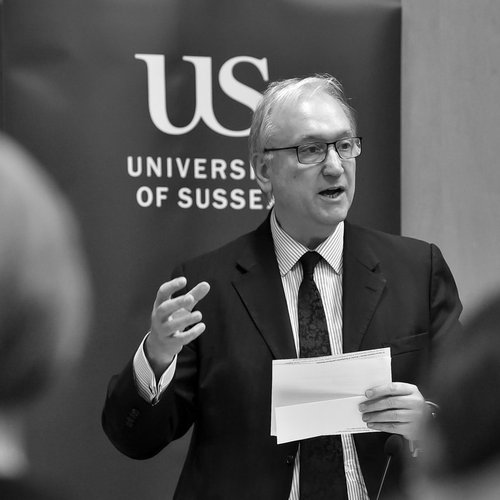7 Dec 2021
Professor Michael Davies is Professor Emeritus in Engineering at the University of Sussex, having previously served as Deputy Vice-Chancellor and Pro-Vice-Chancellor for Research at the University. We chat to Michael about his full and successful career, as well as his experience as an academic in Aotearoa.
What’s your role at the University of Sussex?
Since 2020, I’ve been a Professor Emeritus at the University, having previously served as Deputy Vice-Chancellor and Pro-Vice-Chancellor for Research. Now officially retired from my senior executive roles, I’ve been able to return to my passion for research.
Is there an academic who inspired you to enter the world of academia?
During my studies as both an undergraduate and postgraduate student, I was exceptionally fortunate to be taught/supervised by many inspirational academic engineers. It’s difficult for me to select just one of them!
As an undergraduate at King’s College, University of London, I was first introduced to the field of soil mechanics by Dicky Bassett and became interested in research when conducting my final year project under the supervision of Stephan Jefferis.
It was Dicky who encouraged me to apply to Cambridge University for my PhD where, as a member of the Soil Mechanics Group, I was able to work with highly influential luminaries in the history of the field of soil mechanics, Dick Parry, Peter Wroth and Andrew Schofield.
I learnt a huge amount from each of them – including passing on their deep knowledge of the subject and findings of their groundbreaking research, as well as their enthusiasm to share this with their students.
What challenges have you encountered teaching students remotely over the past 18 months?
As a Visiting Professor at City, University of London, I contribute to the final year geotechnical engineering course in the Civil Engineering degree programme and jointly supervise many undergraduate and postgraduate student projects.
I also jointly supervise a postgraduate student at the University of Western Ontario in Canada. Since April 2020, and until very recently, all teaching activities on both sides of the Atlantic have been conducted remotely.
Once everyone became familiar with the use of MS Teams and Zoom, individual supervision meetings worked very well.
In common with many other lecturers, I’ve adopted a flipped-classroom approach to large class teaching, placing recorded lectures and other resources on the course management system, and then holding live tutorial sessions online.
The biggest challenge to this approach was obtaining engagement from the students in the tutorial sessions. I’m sure that other academics have had the experience of enthusiastically asking a question to a screen full of names and there being no or very little response!
I’m looking forward to being able to deliver my part of the course in person.

How do you introduce and incorporate sustainability concepts into your teaching?
I’ve always been a strong believer that engineering students need to be aware of the complex interactions of the many perspectives and concepts, including sustainability, in an engineered (in the widest sense) system.
Because of this, as Dean of Engineering at the University of Auckland, I introduced the Engineering Systems week and associated courses. In my teaching of geotechnical engineering, I present students with alternative methods of design that can result in less carbon being embodied in infrastructure.
Over the years, what lessons have your students taught you?
Throughout my academic career, I’ve enjoyed interacting with students, although in some of my management roles this was not as frequent as I would have liked.
However, it’s always been rewarding to meet with students when the opportunity arose – even when facing a delegation who had come to complain about something! I’ve learnt from my students that they’re all individuals who have their own hopes, dreams and challenges – and this should be recognised in my interactions with them.
I’ve learnt that many students are highly in tune with the challenges facing society and the environment. Their views deserve to be listened to seriously.
Tell us about three of your career highlights?
Now, this is not just because I’m responding to questions from Engineering New Zealand, but the undoubted highlight of my career was being appointed as Dean of Engineering at the University of Auckland!
The Faculty was an exciting place to work, not least because of the excellence and dedication of the academic and professional staff, and the high-quality, engaged student body.
The role also allowed me to interact with the wider academic and professional engineering community of New Zealand, for which I developed huge and lasting respect.
In my research, the establishment of research groups and geotechnical engineering centrifuge laboratories, at both Cardiff University and the University of Dundee, are both significant milestones in my academic career. They’ve allowed my research to span a wide range of scientific and engineering topics based on the application and development of fundamental soil mechanics.
Throughout my career, I’ve played an active role in the governance of professional bodies. The highlights of this are serving as Chair of the British Geotechnical Association, and Vice-President for Australasia of the International Society for Soil Mechanics and Geotechnical Engineering.
How did you make the shift from being an academic in the classroom to overseeing teaching programmes and strategic direction at engineering schools?
As with most academics in leadership roles, I never planned a career path to become a senior academic manager. However, having been given various responsibilities as a junior academic it became clear to me – and my managers – that I had an aptitude for academic leadership roles.
At the University of Dundee (where I worked before moving to Auckland) I progressed from Head of Department to Dean, whilst continuing to teach and remain a very active researcher with a large research group.
It wasn’t until I was offered the post of Dean of Engineering at Auckland, which has a much larger engineering faculty than at Dundee, that I reached a point of bifurcation in my career when I had to decide whether or not to concentrate on strategic academic leadership rather than a traditional academic role.
As you shifted your career direction, what did you learn in the process?
Universities are people businesses. As a Dean, the success of one’s Faculty depends on employing, and retaining, high-performing academic and professional staff – and attracting well-qualified undergraduate and postgraduate students. Everything else that you do – from ensuring that laboratories and computer rooms are well equipped, to make sure the IT and student records systems are functioning properly, is in support of this.
What advice would you give other academics who are considering branching out into strategic management roles at their tertiary institutions?
First of all, I’ll pass on the advice my former Head of School (who at the time was a Vice-Chancellor) gave to me when I asked him about taking on the role of Dean of Engineering and Physical Sciences at the University of Dundee.
His words were “Up to now, Michael, you have spent most of your time concentrating on solving engineering problems. However, if you become Dean you will find yourself spending 90% of your time dealing with people problems”.
I’ve found this advice to be fairly accurate! However, I would define “people problems” broadly to include addressing positive issues involving staff, students and other Faculty stakeholders and not only those that were problematic.
I would also advise that it’s important not to lose connection with your academic discipline, but to keep involved actively – if only at a low level. I believe this helps to maintain your credibility as an empathetic academic leader, rather than a manager of academics. Additionally, should you wish to do so, it’ll help you to return to research or teaching once you relinquish your leadership roles.
Why are you a member of Engineering New Zealand and an active member of the UK branch?
Throughout my career, I‘ve engaged actively with relevant learned societies and professional bodies. I’ve benefited greatly from exchanging knowledge with both fellow academics and practising engineers, as well as receiving recognition for my professional standing.
On moving to New Zealand, becoming a member of Engineering New Zealand allowed me to network, not only with engineers, but other stakeholders involved in both the formation of engineers and addressing the Nation’s key engineering challenges.
Having benefitted so much from membership of Engineering New Zealand when I lived in New Zealand, I have become an active member of the UK branch because I want to be able to continue to contribute to its work, in general, and to help support the professional development of UK based members.
I also enjoy getting together with my Kiwi friends in Engineering New Zealand for a beer after our technical meetings!
What’s your favourite piece of engineering in the UK?
I feel I should select an outstanding piece of engineering related to my discipline of civil engineering.
In the UK there are many fine examples of bridges and buildings, but the civil engineering accomplishment that stands out for me is the Great Western Railway. The infrastructure of cuttings, embankments, tunnels and bridges are still used for the mainline trains that take me from London to visit my whānau in Wales. It was completed by Brunel in 1838 and incorporated Hawkshaw’s 7km long Severn Tunnel – which for 100 years was the longest underwater tunnel in the world!




